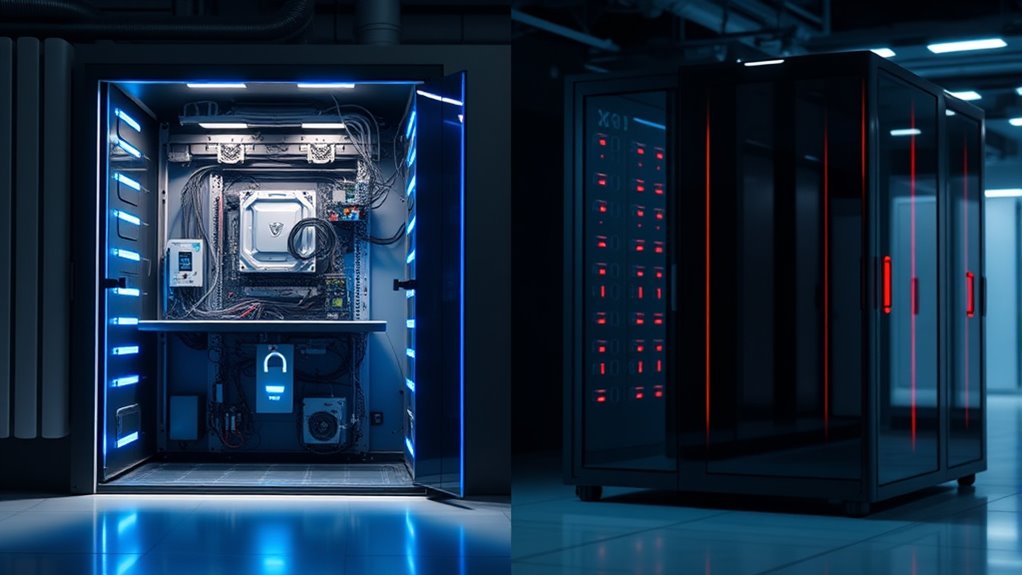From a security standpoint, open-source LLMs give you transparency, so you can scrutinize code, detect biases, and quickly apply patches, reducing vulnerabilities. They also allow internal hosting, lowering data breach risks, and enable modifications to meet your security standards. Proprietary models hide their inner workings, making it harder to verify safety or quickly respond to issues. If you want to understand how these differences can impact your security, keep exploring these key points.
Key Takeaways
- Open-source LLMs enable transparency, allowing security experts to identify and fix vulnerabilities proactively.
- Proprietary models often lack transparency, making it difficult to verify security features and detect hidden risks.
- Open-source frameworks support rapid security updates and patches through community collaboration.
- Internal hosting of open-source models reduces data exposure, whereas proprietary cloud models increase cyber threat risks.
- Modifiability of open-source models allows customization for enhanced security measures, unlike closed proprietary systems.

When choosing between open-source and proprietary large language models (LLMs), understanding their fundamental differences can considerably impact your projects. From a security perspective, two key aspects come into play: model transparency and licensing restrictions. With open-source LLMs, you gain full visibility into how the model operates, allowing you to scrutinize the underlying code, data handling, and training processes. This transparency enables you to identify potential vulnerabilities or biases and address them proactively, reducing the risk of hidden backdoors or malicious code that could compromise your system. Conversely, proprietary models often come with closed-source architectures, meaning you must trust the vendor’s claims about security and safety. This lack of transparency can obscure potential flaws and make it harder to verify if the model has been manipulated or contains embedded risks. Additionally, many open‑source LLMs benefit from community collaboration, which can lead to faster identification and mitigation of security issues through community oversight.
Licensing restrictions further influence your security posture. Open-source models are typically governed by licenses that allow modification, redistribution, and independent auditing. This open framework empowers you to adapt the model to meet specific security standards, implement custom safeguards, or remove any suspicious components. It also facilitates community-driven oversight, where security experts worldwide can review and improve the model’s robustness. However, licensing restrictions on proprietary models can limit your ability to modify or audit the code, forcing you to rely on the vendor’s security assurances. If the vendor’s security measures are insufficient or if they cease support, your project could become vulnerable. Restricted licensing also means you might not have access to the full training data or source code, making it difficult to verify the integrity of the model or identify potential security flaws.
Another consideration is how updates and patches are managed. Open-source models often benefit from rapid community-driven updates that address vulnerabilities swiftly. You can implement these changes immediately, ensuring your system stays protected. Proprietary models depend on the vendor’s release cycle, which might introduce delays in security patches, leaving your system exposed temporarily. Additionally, open-source models allow for better control over data security, as you can host and manage the training environment internally, reducing the risk of data breaches. Proprietary models, especially cloud-based ones, may require sending sensitive data to external servers, increasing exposure to cyber threats.
Frequently Asked Questions
How Do Licensing Differences Impact Security in LLM Deployment?
Licensing implications directly impact security in deploying LLMs because they dictate how you can modify, share, and update the models. If your security policies require strict control, proprietary licenses offer that assurance through restrictions, reducing risks. Conversely, open-source licenses provide transparency but may introduce vulnerabilities if updates aren’t managed properly. You must carefully align licensing terms with your security policies to guarantee safe, compliant deployment of LLMs.
What Are the Risks of Malicious Modifications in Open-Source Models?
Imagine your open-source model as a garden, vulnerable to sneaky weeds—malicious modifications—that can slip in during the supply chain. Model tampering risks turn your trusted tools into wolves in sheep’s clothing, spreading misinformation or compromising data. Because the source code is open, attackers have easier access to exploit weaknesses, making it essential to monitor, verify, and safeguard your supply chain to keep your AI ecosystem secure.
Can Proprietary Models Be More Secure Than Open-Source Ones?
You might think proprietary models are more secure because they limit model transparency and restrict access control, making it harder for malicious actors to understand or manipulate them. However, their closed nature can also hide vulnerabilities, and without open scrutiny, flaws may go unnoticed. Ultimately, security depends on how well access is controlled and how thoroughly the model is tested, regardless of whether it’s open-source or proprietary.
How Do Community Contributions Affect Open-Source Model Security?
Community contributions boost open-source model security by enhancing community oversight and increasing code transparency. When you participate or review, you help identify vulnerabilities quickly, share improvements, and ensure accountability. This collaborative approach allows bugs or security flaws to be addressed faster than in closed systems. So, your involvement fortifies the model’s defenses, making open-source models more resilient and trustworthy through collective scrutiny and transparent development processes.
What Are the Best Practices for Securing Both Open and Proprietary LLMS?
Ironically, securing LLMs isn’t rocket science, yet it often feels like it. You should implement strict access controls, limiting who can use or modify your models, and conduct thorough model validation to catch vulnerabilities. Regular updates and monitoring help detect anomalies early. Whether open or proprietary, prioritizing security measures like these guarantees your models stay safe from misuse, proving that good security still relies on simple, proactive steps.
Conclusion
Ultimately, choosing between open-source and proprietary LLMs depends on your security priorities. For example, if you rely on open-source models, you can audit and improve security features yourself, but it requires expertise. Conversely, proprietary models often come with dedicated security teams but less transparency. You might consider a hybrid approach—using open-source for customization and proprietary for stability—to balance innovation and security. Your decision should align with your organization’s specific risk tolerance and expertise.









